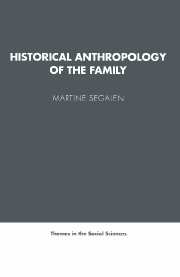Book contents
- Frontmatter
- Contents
- Foreword
- INTRODUCTION
- Part One The area of kinship
- Part Two The making of the domestic group
- Part Three Domestic roles and activities
- 7 ROLES WITHIN THE COUPLE IN THE NINETEENTH CENTURY
- 8 ROLES WITHIN THE PRESENT-DAY COUPLE
- 9 THE DOMESTIC GROUP AND ECONOMIC ROLES
- 10 FAMILY AND SOCIETY
- Notes
- Index
7 - ROLES WITHIN THE COUPLE IN THE NINETEENTH CENTURY
Published online by Cambridge University Press: 14 January 2010
- Frontmatter
- Contents
- Foreword
- INTRODUCTION
- Part One The area of kinship
- Part Two The making of the domestic group
- Part Three Domestic roles and activities
- 7 ROLES WITHIN THE COUPLE IN THE NINETEENTH CENTURY
- 8 ROLES WITHIN THE PRESENT-DAY COUPLE
- 9 THE DOMESTIC GROUP AND ECONOMIC ROLES
- 10 FAMILY AND SOCIETY
- Notes
- Index
Summary
With household structures relatively unchanged, kin relationships still active, marriage still between partners of the same social origins and still combining love and freedom in its ideology, perhaps the family as an institution has not changed? Its structures may seem relatively stable, but behaviour and attitudes have not remained static.
A COMPLEX PROBLEM
The scarcity of sources and their unhelpful nature
It is no easy matter to study roles within the couple in bygone times. Our analysis of relationships between parents and children has given us some idea of the methodological difficulties encountered in studying attitudes, and the problem is even greater with a subject like the present one. We have no statistics comparable to figures for births and marriages to give a long-term overview of developments. Sources for different times and places are not identical and comparison is difficult. When we are dealing with questions of our own time, we can conduct surveys or ask couples about their opinions and their behaviour, but that is not possible when we are dealing with the past. This means that we have to consult literature, or works by experts in folklore, and may get a distorted picture. Historical and anthropological research also provides basic sources, but the approach of the two disciplines is not always exactly the same. There have been very few studies in the area we are now investigating, and up to a point we will have to dig around in research material, some of which deals principally with the organization of work and some with women.
- Type
- Chapter
- Information
- Historical Anthropology of the Family , pp. 201 - 222Publisher: Cambridge University PressPrint publication year: 1986
- 1
- Cited by



